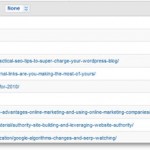As your website grows, your grasp and understanding of SEO should also. The tendency for search engines is, the more content you have, the more keywords and topicality can overlap which may leave search engine algorithms in a quandary attempting to parse and identify which pages have priority over others.

SEO for Large Sites Part One
Although phrase based indexing and retrieval is a prime method for extracting relevance and context, there are multiple layers involved ranging from site architecture, internal links, external deep links and accessibility that all contribute to the formula that decides (based on the least common denominator) which pages are the best match for any given query.
To Assist Search Engines We Suggest that You:
- Define Ranking Objectives.
- Plant Seedling Keywords.
- Determine Preferred Landing Pages
- Reinforce Competitive Keyword Categories.
- Strengthen Internal Linking, Consistently.
- Use Succinct Titles and Meta descriptions (as they can pull their own rankings alone).
- Manage Site Wide Duplicate Content (Custom templates, Noindex, Follow, 301 Redirects, XML Sitemaps).
Define Ranking Objectives – Depending on your keyword positioning and ranking objectives, you will need to select the best method to accomplish them. For example, if your focus is on the Long-Tail of search (meaning less competitive keyword combinations), then link prominence (links from other sites only to the homepage) and flat site architecture (all the pages in the root folder) will work just fine for accomplishing this type of result.
If the market were more specialized and you had less competition (like a high ticket item like MRI equipment), then you could elect for a smaller site with key nodes of relevance (like tips of an iceberg) to wrap up singular, plural and other popular keyword combinations over time.
By adding a series of keyword rich naming conventions and using pagination such as breadcrumb navigation you would reinforce 2 out of the 3 primary metrics search engines assess for relevance (url naming conventions and anchor text) within your own site to subsidize off page ranking factor.
The more work or more streamlined and granular your layers are optimized the less dependent the site becomes on getting a jump-start from other sites and the faster it develops its own authority (to rank on its own coherence/merit).
This strategy would differ from a large ecommerce site with thousands of SKU’s (stock kept units) which means that the model numbers would be the keywords and there would be a large degree of duplicity across the website due to generic mfg. descriptions, etc.
Each keyword has a threshold and tipping point and term frequency within a document, how clearly the hierarchy is promoted within your own website and how large of a footprint your website and link profile make (compared to your competitors) all determines how buoyant your rankings will become.
Plant Seedling Keywords – With keywords, keyword research, modifiers and action words the last thing you want to do is work backwards after the fact. Keywords are the foundation of organic optimization and are the wireframes that eventually support the schema of what a strategic page acting as a piece of the puzzle can accomplish based on its position in the pyramid of relevance.
That pyramid is (1) stable site architecture (2) relevant landing pages based on keyword continuity and (3) a strong internal and external link profile. However, before you can progress to stage 2 or 3, you need to have your hit list of keywords ready to engage the market and search engines alike.
There is no need to recreate the wheel, just look at search trends, related searches (in Google in the footer), keyword research tools and common sense to find a nice cross-section of relevance to use as your blueprint to frame out the site.
If you have a site that lacks coherence, it is not too late to add a new segment to consolidate the ranking factor, execute 301 redirects, add new naming conventions and implement a clear structure that implies a hierarchical method of consistency.
We often implement a an optimized blog on clients sites to concentrate ranking factors that allow us to bypass poorly implemented errors or dated site structures which omit crucial metrics for search engines (such as meta tags, internal links, a one size fits all template, etc).
By baking SEO into the template or new section, you know it is only a matter of time if you manage the areas which impact relevance over time. A stable search engine ranking for a competitive keyword can take anywhere from 4-12 months, but you have to remain focused on the ranking objective over time.
It is not uncommon that when you finally give up and think you have done everything possible to acquire a competitive position (and just relax) that it takes a top 5 or #1 position. The main thing is not to get frustrated or abort inadvertently since you may not see the real result without patience.
So, instead of targeting a handful of keywords, target an entire set of keywords to build the relevance for that subject/topic. By adding internal links to reinforce each other, your pages can implement the buddy system to feed off each other and steamroll the competition since you are using a tight niche of keywords.
To provide a more thorough overview, here is a post from the past on keywords and keyword modifiers that will explain the importance of alternative and supporting keywords and what role they play. This post on theme density will also aid in getting the point across that by concentrating your topics intelligently, rankings are a by-product of great content.
I can see clearly that this topic will require more elaboration, so, if you haven’t already, I encourage you to subscribe to our RSS feed to catch a follow up video and the rest of the topics outlined in this post above. This is a great topic and should have more than just an overview with bullet points.
In the follow up video and posts, I will break out each segment below in greater detail with examples to provide clarity:
- Determining Preferred Landing Pages
- Reinforcing Competitive Keyword Categories.
- Strengthening Internal Linking, Consistently.
- Use Succinct Titles and Meta descriptions (as they can pull their own rankings alone).
- Managing Site Wide Duplicate Content (Custom templates, Noindex, Follow, 301 Redirects, XML Sitemaps).
Stay tuned for more from SEO Design Solutions Blog, where we share free search engine optimization tips, tactics and strategies that you can actually use to get ranked.
Also, if your haven’t already (shameless plug), many of features we discussed are already available in our SEO Ultimate All-In-One Plugin for WordPress (hint, hint). This SEO plugin is definately worth checking out and is modular based so, we will continue to add functionality over time to expand its capabilities each week.









hi
it is a good article share the valuable information keep it up.
Hi, Thanks for posting.
Can you elaborate more on the importance (or irrelevance) of meta tags in terms of SEO.
Thanks!!!
If we all use these tips simultaneously with eminence content and incoming links, our website will show a marvelous ranking growth. Glad to read this good information, I’ll be certain to practice good quality SEO behaviors.
Many SEO companies claim that the SEO process can generate profitable traffic. I do not agree to this statement because I think that the issue is far more comprehensive and needs expertise from other professionals, persons who known more than merely the IT business
@Anders Blogger:
The fact that you disagree and then attempt to use keyword rich anchor text to aid search engine rankings in itself is a dichotomy.
However, to address your point, suggesting to use a suitable site architecture and implement changes to aid in information retrieval and rankings is clearly a benefit.
What is not stated is, yes, you still have to market your product or service. I assume that under this premise you would arguably place pay per click marketing under the same umbrella, yet millions of business turn a profit from both SEO and SEM every day.
If you are suggesting something, then let it be at that, but to come here and make a statement, then bring something to the table instead such as how to craft a value proposition, the A.I.D.A. model or something tangible or simply be labeled as someone building a back link using a counter-stance to what is proposed.
Very important information. Thank you. Best wishies.
We offers best services in Hotels Accommodation in Kerala, Online Booking, Hotels, Special Offer packages, Kerala Honeymoon Packages, Kerala Houseboat Packages, Kerala Hillstation packages, Beach holidays, Family holidays, Indian Ayurveda treatments.
http://www.Keralahoneymoonpackages.org